Investing in the fast-paced world of equity futures requires not just skill but also a strategic mindset. It’s a realm where timing, analysis, and emotional discipline converge to create opportunities for significant gains—or losses. Jimmy Balodimas epitomizes what it means to be a successful swing equity futures trader. Known for his sharp insights, disciplined approach, and unwavering commitment to his trading principles, Balodimas has made a significant impact on how traders navigate the futures markets.
source: Ben de Bourse Ensemble on YouTube
Who Is Jimmy Balodimas?
Jimmy Balodimas is a seasoned trader renowned for his success in swing trading equity futures. With over two decades of experience under his belt, he has developed a trading philosophy that seamlessly combines technical analysis, risk management, and psychological discipline. His journey from a novice trader to a market influencer is a testament to his dedication and the effectiveness of his methods.

- Early Career: Starting as a floor trader in the bustling commodity pits, Balodimas quickly realized the importance of strategy over impulse.
- Evolution as a Trader: Over the years, he transitioned from day trading to swing trading, finding his niche in capturing medium-term market movements.
- Influence on Others: Beyond his trading success, Balodimas has mentored aspiring traders, sharing his insights through seminars, webinars, and publications.

The Art of Swing Trading
Swing trading involves capturing gains in a stock or commodity within an overnight hold to several weeks. Unlike day trading, which requires constant monitoring of the markets, swing trading offers a balance between the rapid pace of intraday trading and the long-term commitment of position trading.
- Equity Futures Explained: Balodimas specializes in equity futures—a derivative contract representing an agreement to buy or sell a specific amount of an equity index, like the S&P 500, at a predetermined price on a future date.
- Leveraging Volatility: By focusing on swing trading within this market, he leverages price volatility to his advantage, capitalizing on significant price movements without the need to hold positions for extended periods.
- Advantages of Swing Trading: This approach allows for flexibility, reduced stress compared to day trading, and the potential for substantial returns by capturing the ‘swings’ in the market.
Why Is His Approach Significant?
Balodimas’s approach simplifies the complexities of futures trading, making it accessible to traders at various levels of experience.
- Structured Trading Plan: He emphasizes the importance of having a clear, well-defined trading plan that outlines entry and exit strategies, risk parameters, and goals.
- Risk Management: Recognizing that preservation of capital is paramount, his strategies include strict risk management techniques to protect against significant losses.
- Emotional Control: Balodimas understands that emotions can be a trader’s worst enemy. His methods teach how to maintain psychological discipline, avoiding impulsive decisions driven by fear or greed.
- Adaptability: In today’s volatile markets, quick decision-making and the ability to adapt to changing conditions are crucial. His approach equips traders with the tools to respond effectively to market shifts.
Jimmy Balodimas and Swing Trading
So, what’s in it for you? This article aims to:
- Examine Jimmy Balodimas’s Trading Strategies: We’ll delve into his core principles and how they contribute to his success, providing insights that you can incorporate into your own trading.
- Understand His Approach to Equity Futures: Learn how he analyzes the market to identify high-probability trading opportunities, including his use of technical analysis and interpretation of market sentiment.
- Apply His Methods to Your Trading: Provide actionable steps to build your own swing trading strategy inspired by Balodimas, complete with tips on risk management and psychological discipline.
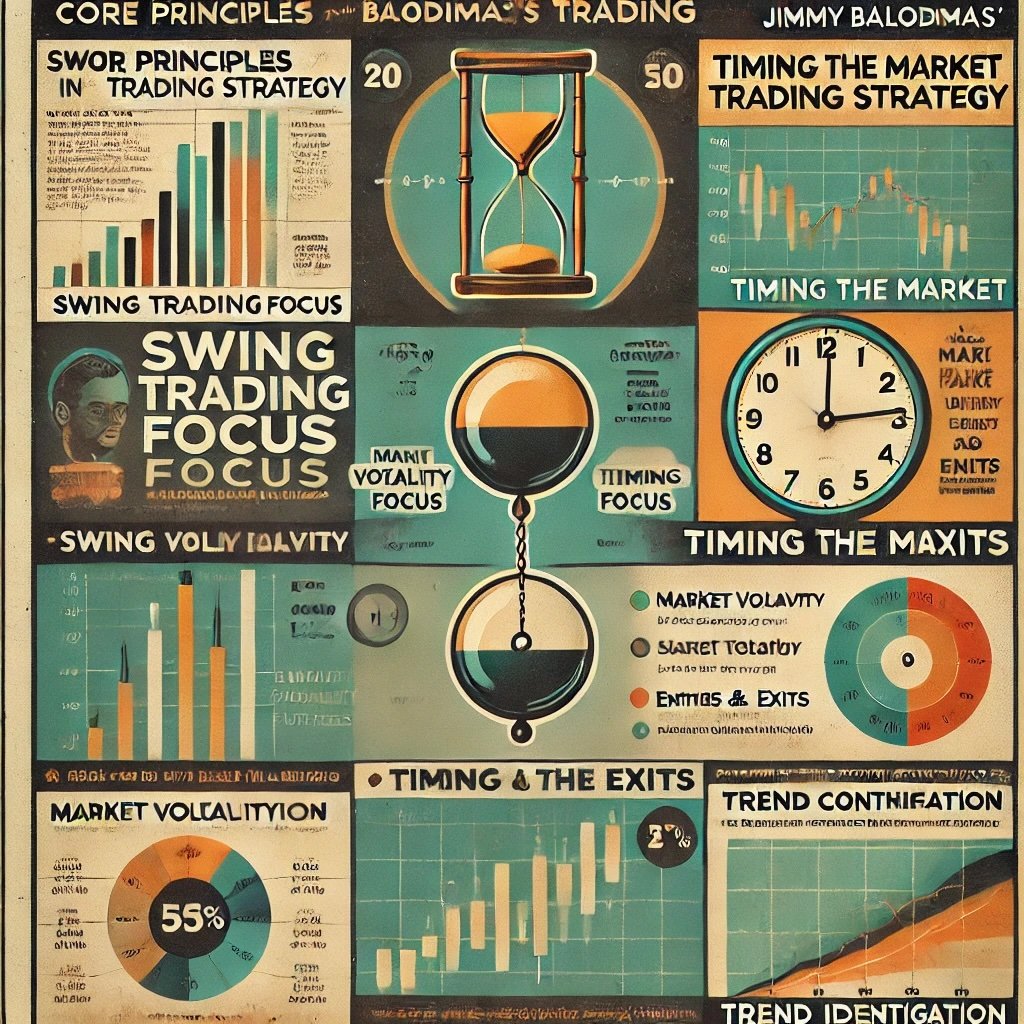
Core Principles of Jimmy Balodimas’s Trading Strategy
To emulate Jimmy Balodimas’s success, it’s essential to understand the core principles that underpin his trading strategy. These principles form the foundation of his approach and are instrumental in navigating the complexities of the equity futures market.
Swing Trading Focus
At the heart of Balodimas’s strategy is swing trading. He aims to capture short- to medium-term price movements to capitalize on market trends. This focus allows him to benefit from significant market moves without the need for constant monitoring or long-term commitments.
Timing the Market
- Market Volatility Leverage: Balodimas leverages market volatility to enter and exit positions within days or weeks, maximizing profit potential while minimizing exposure.
- Strategic Entries and Exits: By identifying key moments when the market is likely to swing, he positions himself ahead of significant price movements.
- Avoiding Noise: Swing trading helps him avoid the ‘noise’ of intraday fluctuations, focusing instead on more meaningful trends.
Trend Identification
- Emerging Trends: He focuses on identifying emerging trends early to maximize profit potential, using tools like moving averages and trendlines.
- Trend Continuation Patterns: Recognizes patterns that indicate the continuation of a trend, allowing him to ride the wave longer.
- Reversal Signals: Equally adept at spotting potential trend reversals, enabling timely exits or opportunities to short the market.
Flexibility
- Adaptable Strategy: His approach allows for adaptability, making it easier to respond to changing market conditions without being locked into long-term positions.
- Market Conditions: Whether the market is bullish, bearish, or sideways, his swing trading strategy can be adjusted to capitalize on prevailing conditions.
- Risk Adjustment: Flexibility extends to adjusting risk parameters based on volatility and other market factors.
By concentrating on swing trading, Balodimas avoids the pitfalls of long-term market unpredictability and the stress of day trading’s rapid pace. This balance provides a sustainable approach that suits his trading style and risk tolerance.
Risk Management
Balodimas places a strong emphasis on capital preservation. He believes that managing risk is just as important, if not more so, than making profitable trades. His disciplined approach ensures that no single trade can significantly impact his overall portfolio.
Stop-Loss Orders
- Limiting Potential Losses: He consistently uses stop-loss orders to limit potential losses, setting them at strategic levels based on technical analysis.
- Automated Protection: Stop-loss orders act as an automatic safeguard, executing trades without the need for constant monitoring.
- Emotional Detachment: By predefining exit points, he removes emotional interference from the decision-making process.
Position Sizing
- Risk Per Trade: Balodimas carefully calculates the size of each position based on his risk tolerance, often limiting risk to a small percentage of his total capital (e.g., 1-2% per trade).
- Volatility Consideration: Adjusts position sizes according to market volatility, reducing exposure during turbulent times.
- Diversification: Spreads risk across multiple positions and markets to avoid overexposure to a single asset.
Risk-to-Reward Ratio
- Favorable Ratios: He ensures that each trade has a favorable risk-to-reward ratio, typically aiming for at least 1:2 or higher. This means that the potential reward is at least twice the potential risk.
- Consistency Over Time: By maintaining a favorable ratio, even a lower win rate can lead to overall profitability.
- Strategic Planning: Incorporates risk-to-reward considerations into his trade planning, not just as an afterthought.
This disciplined approach to risk management protects his portfolio from significant drawdowns, allowing him to stay in the game longer and capitalize on future opportunities.
Technical Analysis
Technical analysis is a cornerstone of Balodimas’s trading strategy. He relies on a variety of tools and techniques to interpret market data and make informed trading decisions.
Chart Patterns
- Pattern Recognition: He studies patterns like flags, pennants, head and shoulders, and wedges to predict price movements.
- Historical Context: Understands that certain patterns have historically led to predictable outcomes, leveraging this knowledge to anticipate future movements.
- Combination of Patterns: Often looks for confluence where multiple patterns or signals align, increasing the probability of a successful trade.
Support and Resistance Levels
- Key Price Levels: Identifying these levels helps him determine optimal entry and exit points, as prices often react predictably when approaching support or resistance.
- Psychological Barriers: Recognizes that these levels can act as psychological barriers for market participants, influencing buying and selling behavior.
- Dynamic Adjustments: Adjusts support and resistance levels as new data emerges, ensuring his analysis remains current.
Indicators
- Relative Strength Index (RSI): Utilizes RSI to identify overbought or oversold conditions, signaling potential reversals.
- Moving Averages: Uses moving averages (e.g., 50-day, 200-day) to smooth out price data and identify trend directions.
- MACD and Stochastic Oscillator: Employs these momentum indicators to assess the strength and direction of trends.
- Bollinger Bands: Analyzes volatility and potential price breakouts or breakdowns.
By using technical analysis, Balodimas makes informed decisions based on market data rather than emotions or speculation. This analytical approach provides a solid foundation for his trading strategy.
Discipline and Consistency
Balodimas attributes much of his success to sticking to a structured trading plan. Discipline and consistency are not just about following rules but about cultivating habits that lead to long-term success.
Trading Plan Adherence
- Predefined Rules: He follows his predefined rules for entry, exit, and risk management without deviation.
- Objective Criteria: Ensures that all trading decisions are based on objective criteria, reducing the influence of biases.
- Routine Execution: Maintains a consistent approach to analyzing markets and executing trades, which helps in measuring performance and making adjustments.
Emotional Control
- Avoiding Impulsive Decisions: Balodimas avoids making impulsive decisions driven by fear or greed, recognizing that emotions can cloud judgment.
- Stress Management Techniques: Employs methods like meditation, exercise, and adequate rest to maintain mental clarity.
- Mindfulness: Practices being present and fully engaged during trading sessions, enhancing focus and decision-making.
Routine
- Daily Analysis: He maintains a consistent daily routine for market analysis, including reviewing charts, news, and economic indicators.
- Preparation: Prepares for trading sessions by setting goals and identifying potential opportunities in advance.
- Reflection: Allocates time for post-trade analysis to learn from successes and mistakes.
Discipline ensures that he remains consistent in his approach, which is crucial for long-term success in volatile markets. It also builds confidence in his strategy, knowing that over time, adherence to his plan yields results.
Continuous Learning
While not explicitly stated in his core principles, continuous learning is implicit in Balodimas’s strategy. The markets are dynamic, and staying informed is essential for sustained success.
Market Analysis
- Staying Updated: He stays updated on market trends, news, and economic indicators that could affect equity futures.
- Global Perspective: Understands that global events can have ripple effects on local markets, incorporating this awareness into his analysis.
- Technological Advances: Keeps abreast of new tools, platforms, and technologies that can enhance trading efficiency.
Self-Reflection
- Reviewing Past Trades: Regularly reviews past trades to identify areas for improvement, recognizing patterns in both successes and failures.
- Journaling: Maintains a trading journal that records not just the technical aspects of trades but also his emotional state and thought processes.
- Feedback Loops: Uses insights gained from reflection to adjust and refine his trading plan.
Adaptability
- Open to New Strategies: Being open to new strategies and tools keeps him ahead of the curve, allowing him to capitalize on emerging opportunities.
- Flexibility in Approach: While disciplined, he is not rigid, understanding that adaptability is necessary in ever-changing markets.
- Learning from Others: Engages with other traders and industry professionals to exchange ideas and learn from different perspectives.
This commitment to learning allows Balodimas to refine his strategy over time, adapting to new market conditions and maintaining a competitive edge.
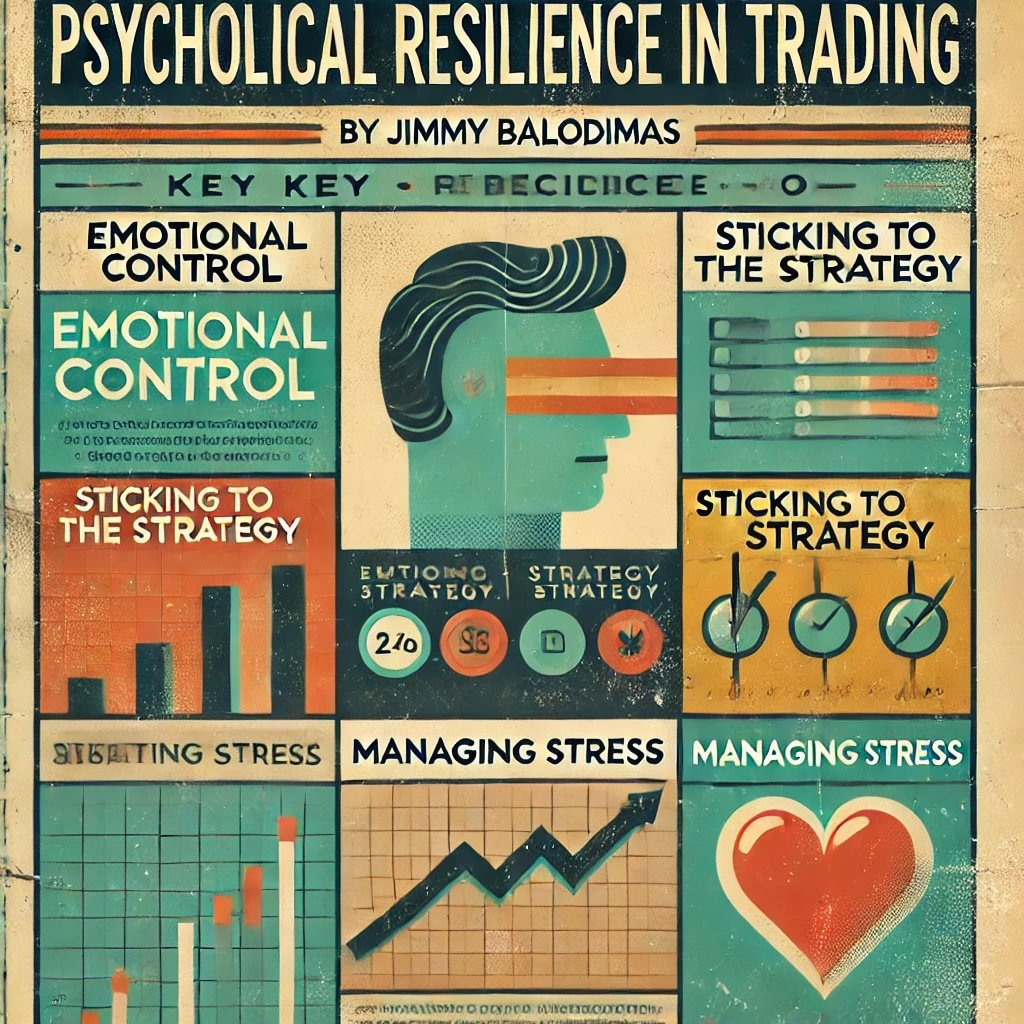
Psychological Resilience
Trading can be emotionally taxing, and Balodimas emphasizes the importance of psychological discipline. Mastery over one’s emotions is often what separates successful traders from the rest.
Stress Management
- Mindfulness and Meditation: Practices techniques like meditation to maintain focus and reduce stress.
- Physical Well-being: Recognizes the connection between physical health and mental performance, ensuring adequate sleep, nutrition, and exercise.
- Work-Life Balance: Maintains a balance between trading and personal life to prevent burnout.
Avoiding Overtrading
- Quality Over Quantity: He knows when to sit on the sidelines and avoid unnecessary risks, focusing on high-probability setups.
- Recognizing Emotional Triggers: Identifies when emotions are influencing his desire to trade, such as revenge trading after a loss.
- Discipline in Action: Adheres to his trading plan, even when tempted to deviate due to boredom or overconfidence.
Confidence without Arrogance
- Trust in Strategy: Balodimas trusts his strategy but remains humble, acknowledging that losses are part of trading.
- Continuous Improvement: Sees each trade as an opportunity to learn, regardless of the outcome.
- Resilience: Bounces back from setbacks without letting them affect his overall performance or outlook.
By maintaining emotional balance, he makes rational decisions that align with his trading plan, enhancing the consistency and reliability of his results.

Balodimas’s Approach to Equity Futures Markets
Jimmy Balodimas’s success isn’t just due to his adherence to core trading principles; it’s also about how he uniquely applies them to the equity futures markets. This section explores his methods for analyzing market trends, understanding volatility, and recognizing high-probability trading opportunities.
Analyzing Trends, Volatility, and Momentum
Balodimas employs a multi-faceted approach to dissect the market, integrating various analytical tools to gain a comprehensive understanding.
Trend Analysis
- Identifying the Dominant Trend: He uses moving averages (such as the 50-day and 200-day) to determine the long-term and short-term trends, filtering out minor fluctuations to focus on the overarching direction.
- Multiple Time Frame Analysis: Balodimas examines charts across different time frames—daily, weekly, monthly—to get a comprehensive view. This helps in aligning short-term trades with long-term trends.
- Trend Confirmation: Indicators like the Average Directional Index (ADX) help confirm the strength of a trend, indicating whether it’s a good time to enter or if the trend is losing momentum.
Volatility Assessment
- Volatility Indicators: Tools like Bollinger Bands and the Volatility Index (VIX) provide insights into market volatility. Widening bands or a rising VIX may signal increased volatility, affecting trade timing and risk management.
- Adjusting Position Sizes: Higher volatility may lead him to reduce position sizes to manage risk, recognizing that volatile markets can lead to larger-than-expected price swings.
- Timing Entries and Exits: Volatility spikes can offer lucrative entry points if timed correctly, but they also require cautious exit strategies to protect profits.
Momentum Indicators
- Relative Strength Index (RSI): Helps identify overbought or oversold conditions, providing signals for potential reversals or continuations.
- Moving Average Convergence Divergence (MACD): Assists in spotting momentum shifts by comparing moving averages of different periods.
- Stochastic Oscillator: Provides signals on potential trend reversals by comparing closing prices to price ranges over a set period.
By combining these analyses, Balodimas builds a comprehensive picture of the market’s current state and potential future movements, enhancing his ability to make informed trading decisions.

Role of Market Sentiment and Macroeconomic Factors
While technical analysis is crucial, Balodimas doesn’t ignore the impact of market sentiment and macroeconomic factors.
Market Sentiment
- News Monitoring: He keeps an eye on financial news outlets for market-moving events, earnings reports, and geopolitical developments that could influence investor behavior.
- Investor Psychology: Understanding the collective behavior of market participants helps in anticipating price movements, especially during times of fear or exuberance.
- Sentiment Indicators: Tools like the Put/Call Ratio, Fear & Greed Index, and Commitment of Traders (COT) reports provide quantitative measures of market sentiment, offering additional layers of analysis.
Macroeconomic Factors
- Economic Indicators: Reports on GDP growth, employment data, inflation rates, and consumer confidence can influence equity futures by affecting economic outlooks.
- Central Bank Policies: Decisions from entities like the Federal Reserve impact market liquidity and sentiment through interest rate adjustments and monetary policies.
- Global Events: Geopolitical developments, trade agreements, and international conflicts can cause significant market shifts, sometimes abruptly.
Balodimas integrates this information to adjust his trading strategy accordingly, ensuring he’s not blindsided by external factors that could negate his technical setups.
Recognizing High-Probability Opportunities
Identifying trades with a high probability of success is a hallmark of Balodimas’s approach. He combines technical and fundamental insights to pinpoint optimal trading opportunities.
Pattern Recognition
- Chart Patterns: He looks for reliable patterns like double tops/bottoms, triangles, flags, and cup-and-handle formations, which historically have predictive value.
- Candlestick Analysis: Patterns like hammer, engulfing patterns, shooting stars, and dojis provide insights into market sentiment and potential reversals.
- Harmonic Patterns: Occasionally utilizes more complex patterns like Gartley or Butterfly patterns for advanced trade setups.
Support and Resistance Levels
- Key Price Levels: Identifying historical support and resistance helps in setting entry and exit points, as these levels often act as barriers or catalysts for price movement.
- Fibonacci Retracements: These levels can indicate potential reversal points by identifying areas where the market may find support or resistance based on mathematical ratios.
- Psychological Numbers: Pays attention to round numbers or significant price levels that may have psychological importance to traders.
Volume Analysis
- Confirming Movements: An increase in volume can validate a price movement, indicating strong interest and commitment from traders.
- Divergence Indicators: Discrepancies between price and volume can signal potential reversals; for example, if prices are rising on decreasing volume, it may indicate weakening momentum.
- On-Balance Volume (OBV): Uses OBV to measure buying and selling pressure, providing insight into the strength of a trend.
Setting Entry and Exit Points
- Entry Signals: Combines indicators and patterns to determine the optimal time to enter a trade, ensuring that multiple factors support the decision.
- Exit Strategies: Predefined criteria for taking profits or cutting losses include target prices based on technical levels and trailing stops to lock in gains.
- Dynamic Adjustments: Will adjust exit points based on evolving market conditions, but always within the framework of his trading plan.
By meticulously analyzing these elements, Balodimas increases his chances of executing successful trades, focusing on setups where the odds are in his favor.
Utilizing Technology and Tools
In the modern trading landscape, technology plays a pivotal role in executing strategies efficiently and effectively.
Trading Platforms
- Advanced Features: He uses advanced platforms that offer real-time data, sophisticated charting tools, and customizable indicators.
- Algorithmic Aids: While not relying solely on algorithms, he may use them to screen for potential trades meeting his criteria, saving time and enhancing accuracy.
- Automation: Utilizes automated order execution for stop-loss and take-profit orders, ensuring timely responses to market movements.
Data Analysis Tools
- Market Scanners: Employs scanners to filter markets based on specific criteria, such as volatility levels, volume spikes, or technical setups.
- Backtesting Software: Uses historical data to test the effectiveness of his strategies, refining them based on empirical evidence.
- Mobile Access: Staying connected via mobile apps allows him to monitor positions and market developments at all times, providing flexibility and responsiveness.
Information Sources
- News Feeds: Subscribes to premium news services that offer faster and more detailed reporting, giving him an informational edge.
- Economic Calendars: Keeps track of upcoming economic events that could impact the markets, planning accordingly.
Risk Assessment Before Trade Execution
Before entering any trade, Balodimas conducts a thorough risk assessment, ensuring that the potential reward justifies the risk.
Risk-to-Reward Ratio
- Calculations: Calculates the risk-to-reward ratio for each trade, only proceeding if it meets his minimum criteria (typically 1:2 or better).
- Scenario Planning: Considers best-case, worst-case, and most likely scenarios to understand potential outcomes.
Probability Analysis
- Historical Success Rates: Evaluates how likely the trade is to succeed based on historical data and current conditions.
- Statistical Tools: May use statistical measures like standard deviation or probability distributions to assess risk.
Contingency Planning
- Stop-Loss Placement: Determines the optimal placement for stop-loss orders to minimize losses if the trade goes against him.
- Exit Strategies: Defines clear criteria for exiting both winning and losing trades, avoiding hesitation or indecision.
- Plan B: Has alternative strategies in place if the market behaves unexpectedly, such as scaling into positions or hedging.
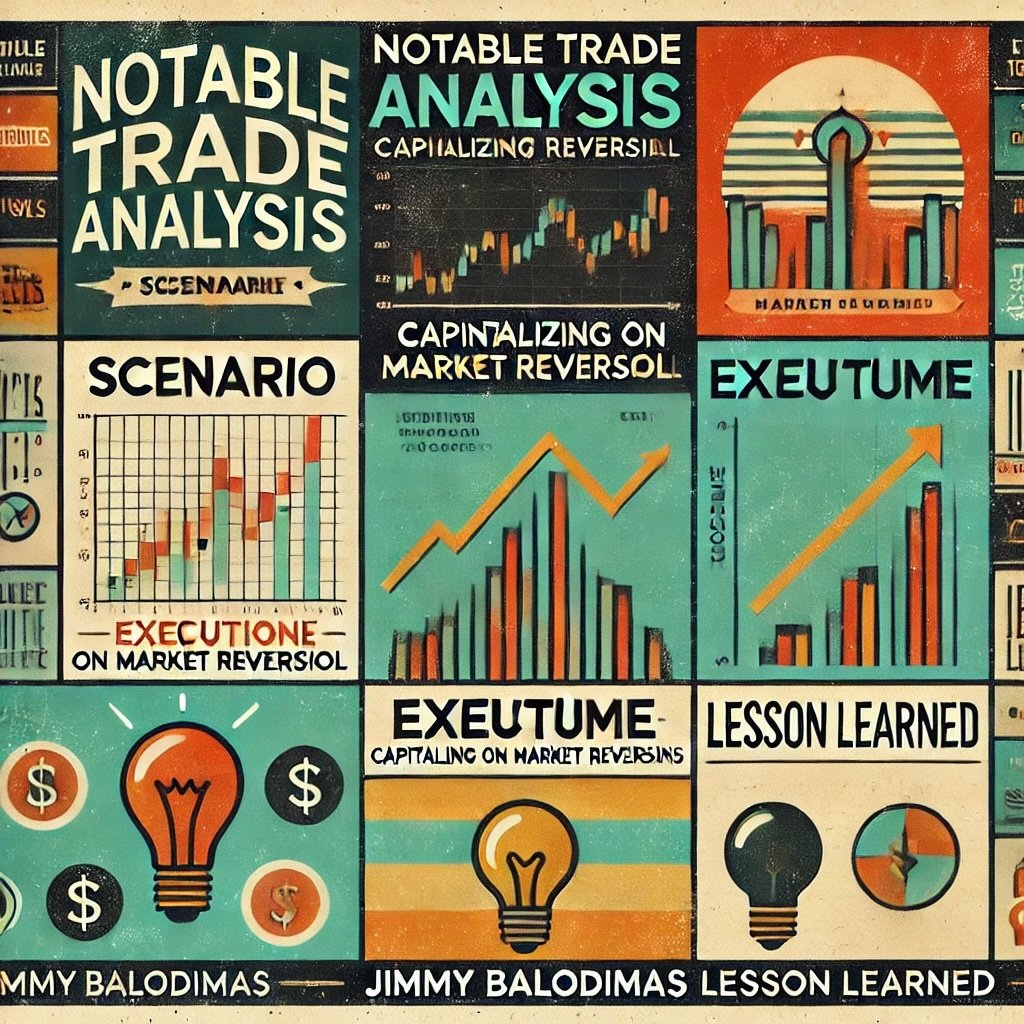
Notable Trades and Lessons Learned
Examining Jimmy Balodimas’s most impactful trades offers practical insights into how his swing trading approach operates in real-world scenarios. While individual trades may vary, the underlying principles remain consistent. Let’s delve into some of his notable trades and the lessons they impart.
Trade Analysis 1: Capitalizing on Market Reversal
The Scenario
- Market Condition: The equity futures market had been in a prolonged downtrend due to economic uncertainty and negative investor sentiment.
- Balodimas’s Observation: He noticed a double bottom pattern forming on the charts, a classic reversal signal indicating that the market may be poised to turn upwards.
- Indicators Used: The Relative Strength Index (RSI) showed oversold conditions below 30, and there was increasing volume on up days, suggesting accumulation.
Execution
- Entry Point: Balodimas entered a long position as the price broke above the resistance level of the double bottom pattern, confirming the reversal.
- Risk Management: Placed a stop-loss order just below the recent low (the second bottom) to minimize potential loss if the reversal failed.
- Exit Strategy: Aimed for a profit target based on the height of the pattern projected upward from the breakout point, aligning with a previous resistance level.
Outcome
- Result: The market reversed as anticipated, and the trade reached the profit target within two weeks, capturing a significant upward movement.
- Profit: Achieved a 3:1 risk-to-reward ratio, reinforcing the effectiveness of his risk management strategy.
- Trade Duration: Held the position for approximately 14 days, aligning with his swing trading timeframe.
Lesson Learned
- Pattern Recognition Is Powerful: Identifying reliable chart patterns like the double bottom can lead to high-probability trades.
- Risk Management Protects Capital: By setting a stop-loss, he limited his downside risk, ensuring that a failed trade wouldn’t significantly impact his portfolio.
- Patience Pays Off: Waiting for confirmation before entering ensured a higher chance of success, avoiding premature entries based on speculation.
Trade Analysis 2: Navigating High Volatility
The Scenario
- Market Condition: A major geopolitical event caused increased volatility in the equity futures market, leading to rapid and unpredictable price swings.
- Balodimas’s Observation: Noticed that volatility indicators like the VIX were spiking, and Bollinger Bands were widening significantly.
- Indicators Used: Monitored intraday volatility measures and short-term momentum indicators to gauge market conditions.
Execution
- Adjustment: Reduced position sizes to account for higher volatility, acknowledging that larger price movements could amplify losses.
- Strategy: Focused on shorter-term trades to capitalize on rapid price movements, often entering and exiting positions within a day or two.
- Risk Management: Tightened stop-loss orders to protect against sudden reversals, ensuring that any losses would be contained.
Outcome
- Result: Managed to secure several small gains while avoiding significant losses, capitalizing on quick opportunities presented by the volatile market.
- Profit: Cumulative gains added up over the volatile period, contributing positively to his overall performance.
- Emotional State: Maintained composure despite the chaotic market, relying on his disciplined approach.
Lesson Learned
- Adaptability Is Key: Adjusting strategies in response to market conditions can protect capital and exploit opportunities that might not exist in more stable environments.
- Volatility Requires Caution: Higher volatility necessitates stricter risk management and more conservative position sizing.
- Small Wins Accumulate: Consistent small profits can lead to significant overall gains, especially when compounded over time.
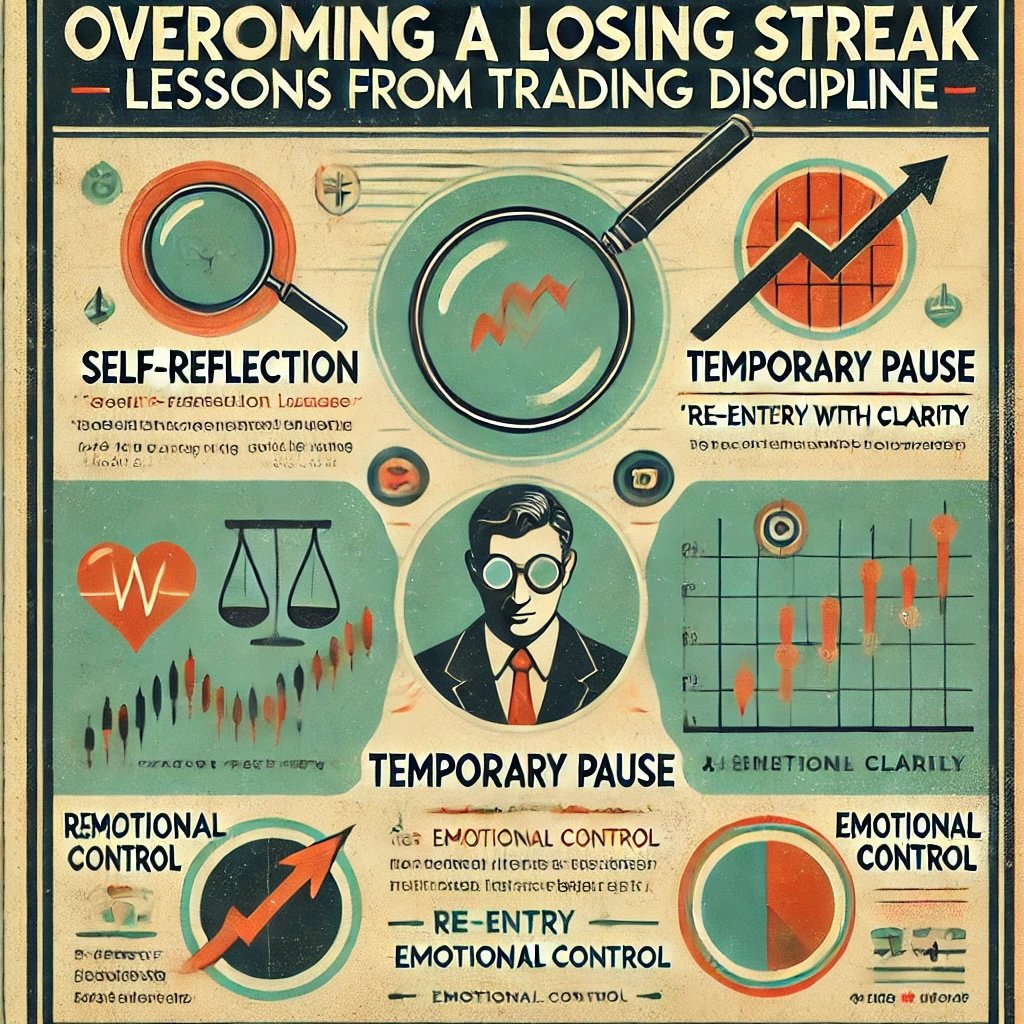
Trade Analysis 3: Overcoming a Losing Streak
The Scenario
- Market Condition: The market was choppy with no clear trend, leading to several unsuccessful trades as patterns failed to materialize.
- Balodimas’s Challenge: Faced a series of losses that tested his emotional resilience and confidence in his strategy.
Execution
- Self-Reflection: Took a step back to review his recent trades and identify patterns in his decision-making that may have contributed to the losses.
- Adjustment: Decided to pause trading temporarily to reassess market conditions and ensure his strategy was still valid in the current environment.
- Re-entry Strategy: Waited for clearer signals and more favorable market conditions before re-engaging in the market, avoiding the temptation to ‘chase’ losses.
Outcome
- Result: Avoided further losses during the uncertain period and returned to profitability once the market stabilized and his setups reappeared.
- Emotional State: Maintained confidence without letting emotions dictate his actions, demonstrating strong psychological discipline.
- Long-Term Impact: The experience reinforced the importance of discipline and patience, contributing to his development as a trader.
Lesson Learned
- Emotional Control Matters: Recognizing when to step back can prevent impulsive decisions driven by frustration or the desire to recoup losses quickly.
- Review and Adapt: Analyzing past trades helps in making necessary adjustments, ensuring continuous improvement.
- Discipline Over Emotion: Sticking to the trading plan despite setbacks is crucial for long-term success.
Relevance to Today’s Markets
The lessons from Balodimas’s trades are particularly relevant in today’s fast-moving and often unpredictable markets.
- Market Volatility Is Constant: With global events impacting markets regularly—from pandemics to political upheavals—adaptability and risk management are more important than ever.
- Technical Analysis Remains Valuable: Chart patterns and indicators continue to be effective tools for traders, providing a framework for making informed decisions.
- Psychological Discipline Is Crucial: Emotional control can be the difference between success and failure, especially when markets are unpredictable.

Risk Management and Psychological Discipline
Success in trading isn’t solely about making profitable trades; it’s also about managing risk and maintaining psychological discipline. Jimmy Balodimas places significant emphasis on these aspects, recognizing that they are critical components of long-term success in volatile markets.
Risk Management Techniques
Balodimas employs several strategies to preserve capital and manage risk effectively, ensuring that he can withstand periods of market adversity.
Position Sizing
- Risk Per Trade: He limits his risk on any single trade to a small percentage of his total capital, often around 1-2%. This approach prevents any one trade from having a devastating impact on his portfolio.
- Calculating Position Size: Uses the distance between entry price and stop-loss to determine how many contracts to trade, aligning potential losses with his risk tolerance.
- Diversification: Avoids overexposure to a single market or sector by diversifying his trades across different assets or indices.
Stop-Loss Orders
- Protective Stops: Places stop-loss orders immediately after entering a trade, ensuring automatic exit if the market moves against him.
- Trailing Stops: Adjusts stop-loss levels as the trade moves in his favor to lock in profits, allowing winners to run while protecting gains.
- Avoiding Catastrophic Losses: Stops prevent significant losses that could deplete trading capital, enabling him to continue trading even after a series of unsuccessful trades.
Risk-to-Reward Ratio
- Favorable Ratios: Seeks trades with a minimum risk-to-reward ratio of 1:2 or higher, ensuring that potential profits justify the risks taken.
- Consistency: By maintaining a favorable ratio, he can be profitable even if he’s only correct on a portion of his trades.
- Strategic Planning: Incorporates risk-to-reward considerations into his trade selection, focusing on setups that offer the most favorable outcomes.
Hedging Strategies
- Using Options: Occasionally uses options contracts to hedge positions, providing insurance against adverse market movements.
- Inverse ETFs: May utilize inverse funds to offset potential losses in certain market conditions, especially during market downturns.
- Diversified Portfolio: Holds positions that may have inverse correlations, reducing overall portfolio volatility.
Psychological Discipline
Maintaining emotional control is paramount in trading, and Balodimas has developed techniques to stay disciplined, recognizing that psychological factors can significantly impact performance.
Emotional Awareness
- Recognizing Emotional States: Acknowledges feelings of fear, greed, or frustration without acting on them impulsively.
- Stress Management Techniques: Practices mindfulness, meditation, and deep-breathing exercises to stay calm and focused.
- Emotional Intelligence: Understands how emotions can influence decision-making and takes steps to mitigate negative effects.
Sticking to the Plan
- No Impulsive Decisions: Avoids making trades based on hunches, rumors, or external noise, adhering strictly to his trading plan.
- Following Rules: Ensures that every trade aligns with predefined criteria, reinforcing discipline and consistency.
- Accepting Losses: Understands that losses are part of trading and doesn’t let them affect future decisions or erode confidence.
Building Resilience
- Learning from Mistakes: Analyzes losing trades to identify errors and areas for improvement, viewing setbacks as learning opportunities.
- Maintaining Confidence: Trusts in his strategy and abilities, even during drawdowns, maintaining a positive mindset.
- Avoiding Overtrading: Knows when to step back and refrain from trading in unfavorable conditions, preventing fatigue and emotional exhaustion.
How Mastering Risk and Psychology Leads to Success
Combining risk management with psychological discipline creates a robust framework for trading, enhancing both performance and sustainability.
Consistency Over Time
- Steady Performance: By managing risk and staying disciplined, Balodimas achieves consistent results over the long term, avoiding the boom-and-bust cycles that plague many traders.
- Avoiding Burnout: Emotional control prevents the fatigue and stress that lead to poor decision-making, ensuring that he can maintain peak performance.
Capital Preservation
- Longevity in the Market: Protecting capital allows him to take advantage of future opportunities, recognizing that survival is key in the trading world.
- Compounding Returns: Consistent gains, even if modest, can compound significantly over time, building substantial wealth.
Competitive Edge
- Emotional Intelligence: Many traders fail due to emotional decisions; Balodimas’s discipline gives him an advantage by enabling rational, objective decision-making.
- Risk Mitigation: Effective risk management reduces the likelihood of catastrophic losses that can end a trading career, providing stability and confidence.
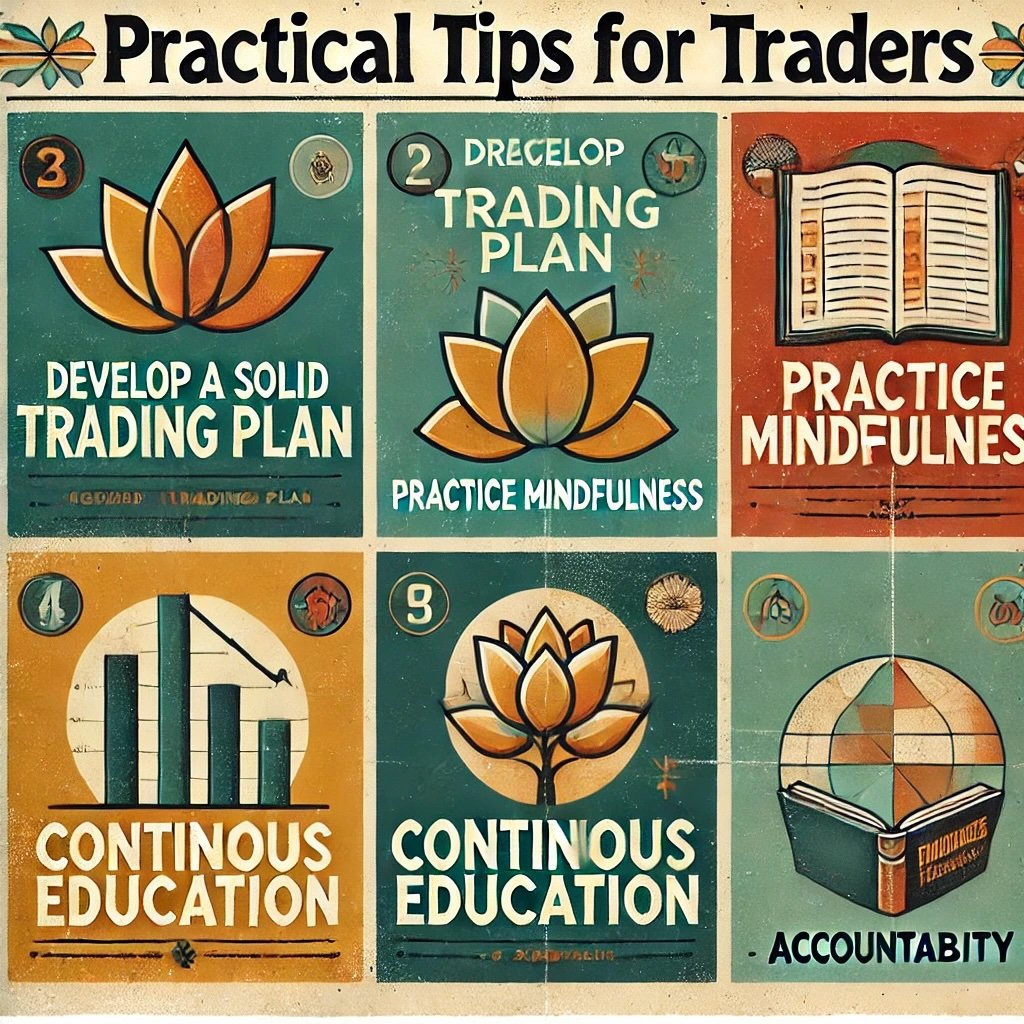
Practical Tips for Traders
Develop a Solid Trading Plan
- Define Rules: Clearly outline entry and exit criteria, risk parameters, and strategies, leaving little room for ambiguity.
- Test the Plan: Backtest strategies to ensure they are effective before applying real capital, validating assumptions.
Practice Mindfulness
- Stay Present: Focus on the current market conditions rather than dwelling on past losses or fixating on future gains.
- Emotional Check-Ins: Regularly assess your emotional state to prevent it from influencing decisions, implementing stress-reduction techniques as needed.
Continuous Education
- Learn About Risk Management Tools: Understand different methods for managing risk, including advanced techniques like hedging.
- Psychological Training: Consider reading books or taking courses on trading psychology to develop mental resilience.
Accountability
- Trading Journal: Keep a detailed record of all trades, including emotional states and thought processes, providing a valuable resource for reflection.
- Mentorship: Engage with experienced traders who can provide guidance, objective feedback, and support.

Building a Balodimas-Inspired Swing Trading Strategy
Ready to put theory into practice? This section provides a step-by-step guide to creating your own swing trading strategy inspired by Jimmy Balodimas’s methods. By following these steps, you can develop a structured approach to navigate the equity futures markets effectively.
Step 1: Define Your Trading Goals
- Set Clear Objectives: Determine whether you’re aiming for steady income, capital growth, or a combination of both. Clarify your financial goals to align your strategy accordingly.
- Assess Risk Tolerance: Understand your comfort level with risk, recognizing how much you’re willing to lose on any given trade or over a specific period.
- Determine Time Commitment: Evaluate how much time you can dedicate to trading and analysis, ensuring that your approach is realistic given your lifestyle.
Step 2: Establish a Trading Plan
- Trading Style Confirmation: Ensure that swing trading aligns with your personality and goals, appreciating the balance between holding periods and market engagement.
- Market Focus: Decide which equity futures contracts you’ll trade, such as S&P 500 futures, NASDAQ futures, or other indices that suit your expertise and interest.
- Risk Parameters: Define how much you’re willing to risk per trade and overall, setting clear limits to guide your decision-making.
Step 3: Learn Technical Analysis
- Chart Patterns: Study common patterns like flags, triangles, double tops/bottoms, and head and shoulders. Understanding these patterns is crucial for identifying trading opportunities.
- Indicators: Familiarize yourself with tools like RSI, MACD, moving averages, Bollinger Bands, and others that can enhance your analysis.
- Support and Resistance: Practice identifying key price levels where the market has historically reacted, aiding in setting entry and exit points.
Step 4: Develop Entry and Exit Criteria
- Entry Signals: Combine indicators and patterns to create clear, objective entry rules. Ensure that multiple factors align before entering a trade.
- Exit Strategies: Define profit targets and stop-loss levels in advance, adhering to your risk-to-reward requirements.
- Risk-to-Reward Ratio: Aim for a minimum ratio of 1:2 to ensure profitability over time, adjusting as necessary based on your analysis.
Step 5: Implement Risk Management Techniques
- Position Sizing: Use a calculator or formula to determine the appropriate number of contracts, aligning with your risk parameters.
- Stop-Loss Orders: Always set stop-loss orders immediately after entering a trade to protect against unexpected market movements.
- Diversification: Avoid concentrating your capital in a single trade or market, spreading risk across multiple positions.
Step 6: Incorporate Psychological Discipline
- Emotional Awareness: Develop techniques to recognize and control emotional responses, such as mindfulness practices or regular self-assessments.
- Routine Establishment: Create a consistent daily routine for market analysis and trade execution, fostering discipline.
- Patience and Restraint: Wait for setups that meet all your criteria before entering a trade, avoiding impulsive decisions.
Step 7: Utilize Technology and Tools
- Trading Platform Selection: Choose a platform that offers the tools and features you need, such as advanced charting, real-time data, and customizable interfaces.
- Data Feeds and News Services: Ensure you have access to reliable, up-to-date information to inform your trading decisions.
- Educational Resources: Leverage online courses, webinars, tutorials, and books to enhance your skills continuously.
Step 8: Backtest Your Strategy
- Historical Data Utilization: Use past market data to test your trading plan, identifying strengths and weaknesses.
- Analyze Results: Look for patterns in wins and losses, refining your strategy based on empirical evidence.
- Adjust as Needed: Make necessary tweaks based on backtesting outcomes, ensuring that your plan is robust and effective.
Step 9: Start Small and Scale Up
- Paper Trading: Consider practicing with a demo account before risking real capital, gaining confidence in your strategy.
- Small Positions: Begin with smaller position sizes to minimize risk as you transition to live trading.
- Monitor Performance: Keep detailed records to track your progress, using insights to improve.
Step 10: Continuous Improvement
- Review Trades Regularly: Analyze your trades to identify strengths and weaknesses, embracing a mindset of continuous learning.
- Stay Informed: Keep up with market news, trends, and economic indicators, ensuring that your strategy remains relevant.
- Adaptation: Be willing to adjust your strategy in response to market changes, maintaining flexibility.
Tips for Identifying Trades, Managing Risk, and Adapting Over Time
Identifying Trades
- Screening Tools: Use software or platforms that help identify potential setups based on your criteria, saving time and enhancing efficiency.
- Set Alerts: Configure alerts for when certain conditions are met, allowing you to respond promptly.
- Watchlists: Maintain a list of assets that meet your criteria, focusing your analysis on relevant markets.
Managing Risk
- Consistent Application: Apply your risk management rules to every trade without exception, reinforcing discipline.
- Regular Audits: Periodically review your risk parameters to ensure they still align with your goals and market conditions.
- Emergency Plans: Have protocols in place for unexpected market events, such as sudden volatility spikes.
Adapting Over Time
- Market Conditions Awareness: Adjust your strategy to suit different market environments, recognizing that what works in a trending market may not in a sideways one.
- Learning from Experience: Use each trade as a learning opportunity, embracing both successes and failures.
- Networking: Engage with other traders to share insights and strategies, fostering a supportive community.
Swing Equity Futures Like Jimmy Balodimas: 12-Question FAQ (Timing, Risk, Psychology, and Process)
What defines Jimmy Balodimas’s swing trading style in equity futures?
Balodimas focuses on multi-day to multi-week moves in index futures (e.g., S&P/Nasdaq). He combines clean technical structures (trend, momentum, and key levels) with strict risk controls, predefines exits, and emphasizes psychological discipline to avoid noise from intraday whipsaws.
How long is a typical holding period, and what catalysts matter?
Most positions last 3–15 trading days, sometimes extending to ~4–6 weeks if the trend persists. Catalysts include macro prints (CPI, jobs), FOMC meetings, earnings seasons’ breadth/leadership shifts, and volatility regime changes that can accelerate or stall swings.
Which technical tools anchor his entries and exits?
He leans on:
• Trend: 20/50/200-day moving averages, higher-high/higher-low (or the inverse).
• Momentum: RSI/MACD or Stoch for turns/continuations.
• Structure: Breakouts from flags/triangles, retests of broken trendlines, and confluence at prior highs/lows, VWAPs, and Fibonacci retracements for targets/stops.
How does he size positions and set stops in futures?
Risk per idea is small and consistent (often ~0.5–1.5% of equity). Contract count is derived from distance to the invalidation level (ATR- or structure-based). Hard stops sit beyond the technical “line in the sand,” and trailing stops ratchet under swing lows/highs as price advances.
What risk-to-reward does he target?
He seeks ≥1:2 as a baseline; 1:3+ when volatility and structure allow. Trades that don’t offer sufficient asymmetry are skipped. Partial profits are taken at predefined levels; the remainder rides with a trail to capture extended moves.
How are volatility and regime shifts incorporated?
When IV/VIX expand and ranges open, he reduces size and widens stops to respect larger bars; in compressed, mean-reverting tape, he favors quicker profit-taking and tighter management. Regime filters keep him from forcing trend tactics in choppy conditions.
What does his daily/weekly workflow look like?
Weekly: top-down scan (macro calendar, breadth, sector leadership), build A-setups, define levels and scenarios.
Daily: pre-market plan, alerts at key levels, execute only if the thesis + risk box align. Post-close review logs entries, exits, rule adherence, and improvements.
How does he handle psychology—especially after losses?
He uses predefined rules to prevent revenge trading, caps daily and weekly loss limits, steps back during chop, and conducts short post-mortems (process > P&L). Mindfulness, sleep, and exercise are part of the playbook to keep decisions objective.
What are common mistakes swing futures traders should avoid?
Oversizing into volatile days, moving stops “just this once,” crowding correlated positions (ES + NQ + YM all long), trading every minor headline, and ignoring rollover/liquidity. Another big leak: adding to losers without a fresh, superior setup.
How does he adapt the playbook across bull, bear, and range markets?
Bull: buy pullbacks to rising MAs, trendline retests, and breakouts with time-based stops.
Bear: short failed rallies into resistance, lower-highs, and breakdown retests.
Range: fade extremes with tight risk or stand aside until expansion returns.
What tools/platform features does he rely on?
Reliable futures platform with OCO orders, alerts, and bracketed stops; market scanners for momentum/structure; economic calendars; ATR/volatility dashboards; and a trade journal (spreadsheet or app) that captures setup tags and rule-adherence scores.
How can a beginner implement a Balodimas-inspired starter plan in 30 days?
Week 1: Write a one-page plan (markets, setups, risk per trade, loss limits).
Week 2: Backtest 1–2 simple patterns; define entries/stops/targets.
Week 3: Paper trade 10 setups; track metrics and emotions.
Week 4: Go live with micro contracts (MES/MNQ), tiny size, and strict journaling.
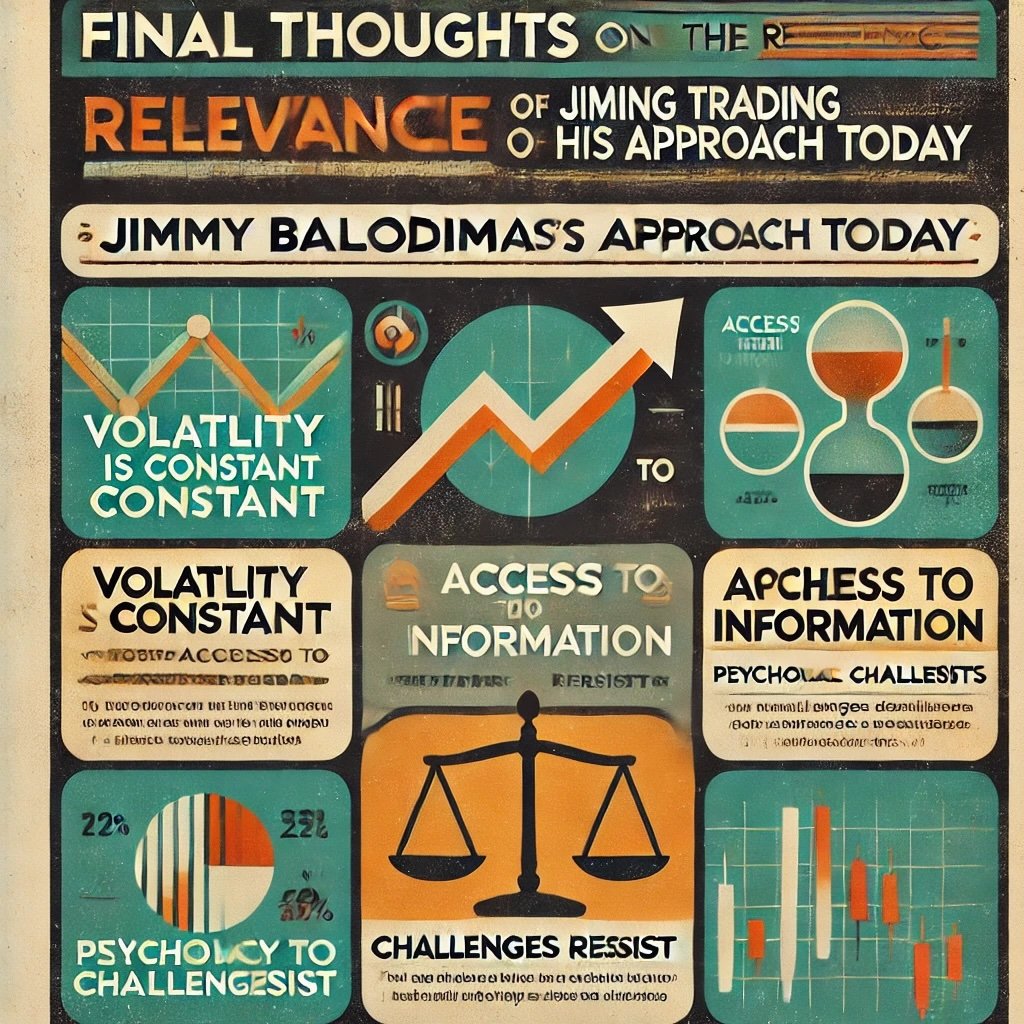
Final Thoughts on the Relevance of His Approach Today
Jimmy Balodimas’s approach remains highly relevant in today’s markets for several reasons:
- Volatility Is Constant: Markets continue to experience significant fluctuations, providing opportunities for swing traders who are prepared to capitalize on them.
- Access to Information: Technology has made it easier than ever to access the tools and data needed, leveling the playing field.
- Psychological Challenges Persist: Emotional discipline is as crucial now as it ever was, with information overload and rapid market movements testing traders’ resolve.
Encouragement to Apply These Strategies
- Start Now: There’s no better time to begin building your trading strategy, leveraging the insights from successful traders like Balodimas.
- Be Patient: Success won’t happen overnight, but consistency and perseverance pay off.
- Seek Support: Don’t hesitate to seek mentorship or join trading communities, benefiting from shared knowledge and experience.
By following these steps and applying the principles outlined in this article, you’re well on your way to developing a robust swing trading strategy inspired by one of the best in the field. Remember, trading is a journey of continuous learning and growth.
Happy Trading!
Important Information
Comprehensive Investment Disclaimer:
All content provided on this website (including but not limited to portfolio ideas, fund analyses, investment strategies, commentary on market conditions, and discussions regarding leverage) is strictly for educational, informational, and illustrative purposes only. The information does not constitute financial, investment, tax, accounting, or legal advice. Opinions, strategies, and ideas presented herein represent personal perspectives, are based on independent research and publicly available information, and do not necessarily reflect the views or official positions of any third-party organizations, institutions, or affiliates.
Investing in financial markets inherently carries substantial risks, including but not limited to market volatility, economic uncertainties, geopolitical developments, and liquidity risks. You must be fully aware that there is always the potential for partial or total loss of your principal investment. Additionally, the use of leverage or leveraged financial products significantly increases risk exposure by amplifying both potential gains and potential losses, and thus is not appropriate or advisable for all investors. Using leverage may result in losing more than your initial invested capital, incurring margin calls, experiencing substantial interest costs, or suffering severe financial distress.
Past performance indicators, including historical data, backtesting results, and hypothetical scenarios, should never be viewed as guarantees or reliable predictions of future performance. Any examples provided are purely hypothetical and intended only for illustration purposes. Performance benchmarks, such as market indexes mentioned on this site, are theoretical and are not directly investable. While diligent efforts are made to provide accurate and current information, “Picture Perfect Portfolios” does not warrant, represent, or guarantee the accuracy, completeness, or timeliness of any information provided. Errors, inaccuracies, or outdated information may exist.
Users of this website are strongly encouraged to independently verify all information, conduct comprehensive research and due diligence, and engage with qualified financial, investment, tax, or legal professionals before making any investment or financial decisions. The responsibility for making informed investment decisions rests entirely with the individual. “Picture Perfect Portfolios” explicitly disclaims all liability for any direct, indirect, incidental, special, consequential, or other losses or damages incurred, financial or otherwise, arising out of reliance upon, or use of, any content or information presented on this website.
By accessing, reading, and utilizing the content on this website, you expressly acknowledge, understand, accept, and agree to abide by these terms and conditions. Please consult the full and detailed disclaimer available elsewhere on this website for further clarification and additional important disclosures. Read the complete disclaimer here.




